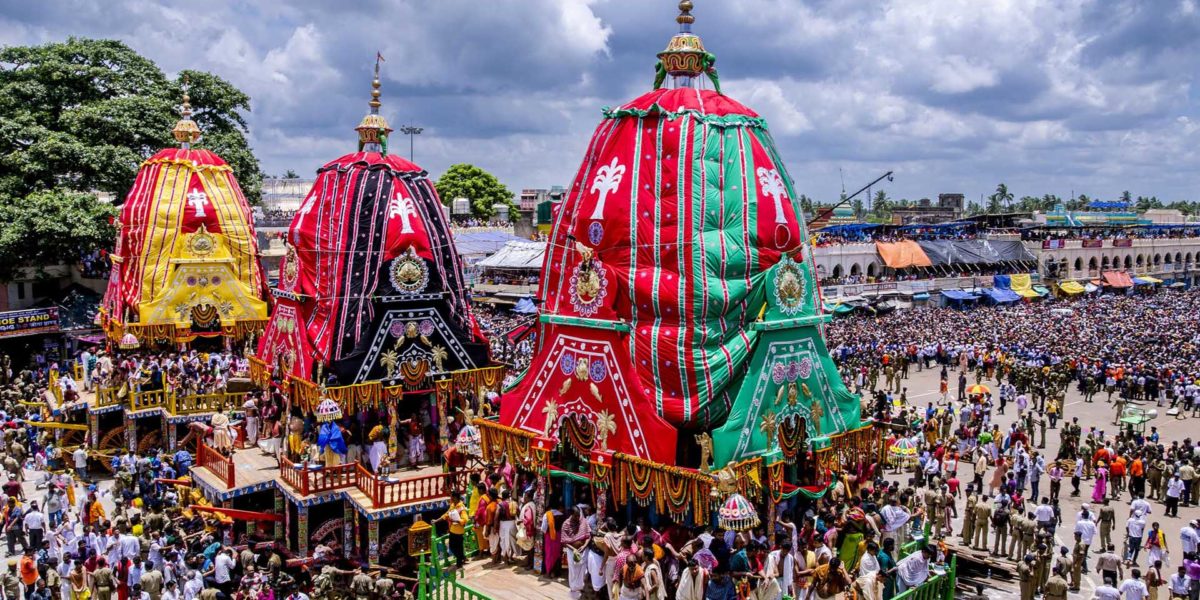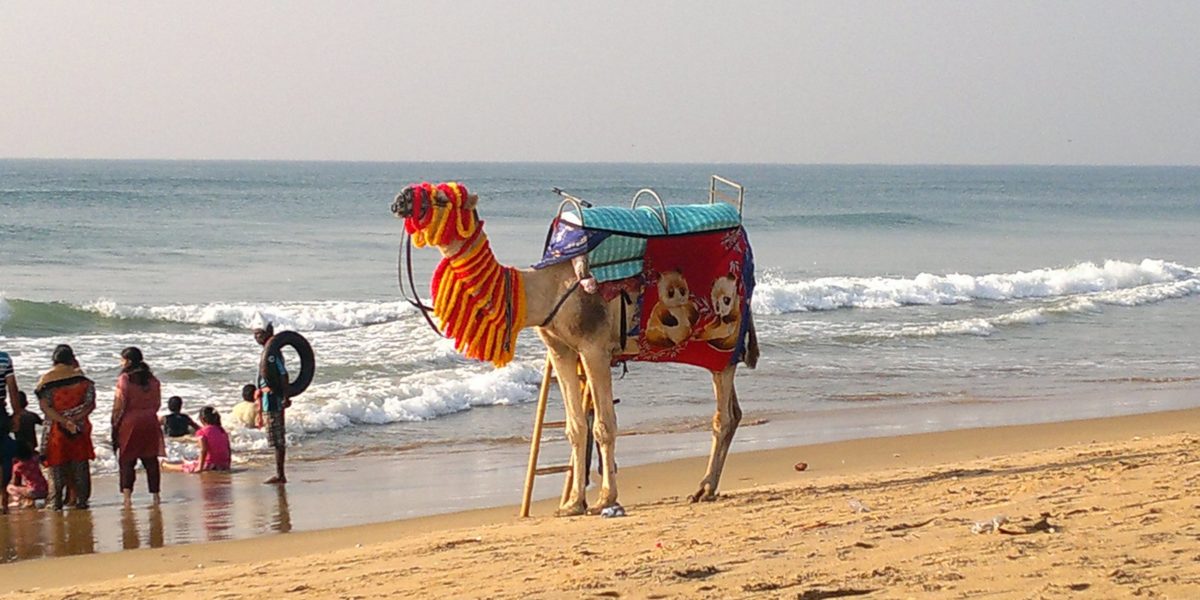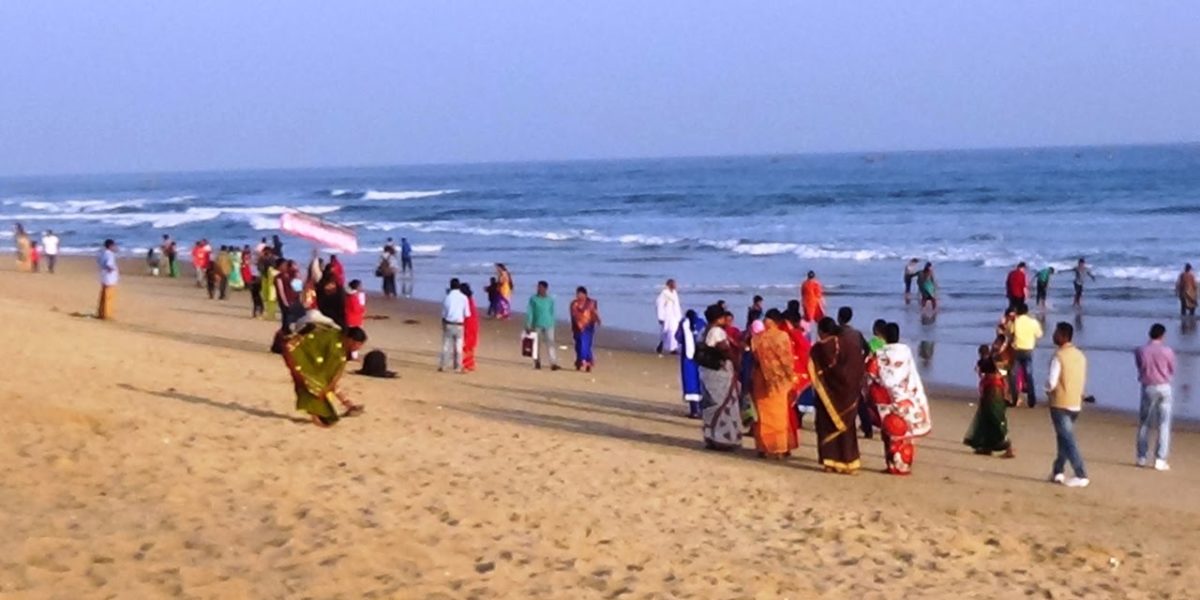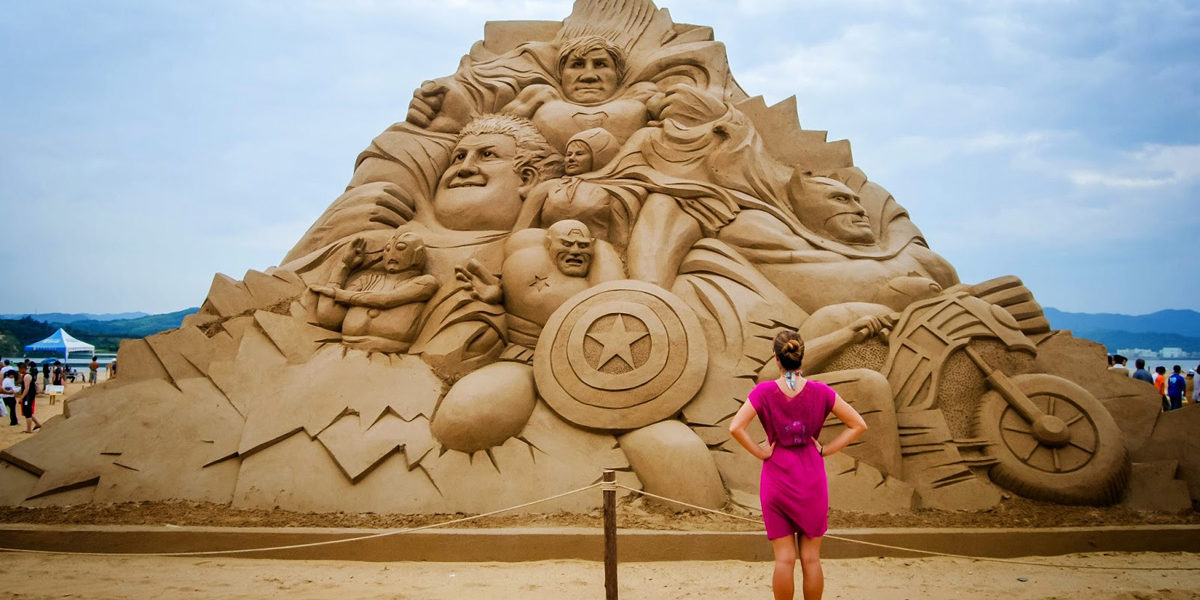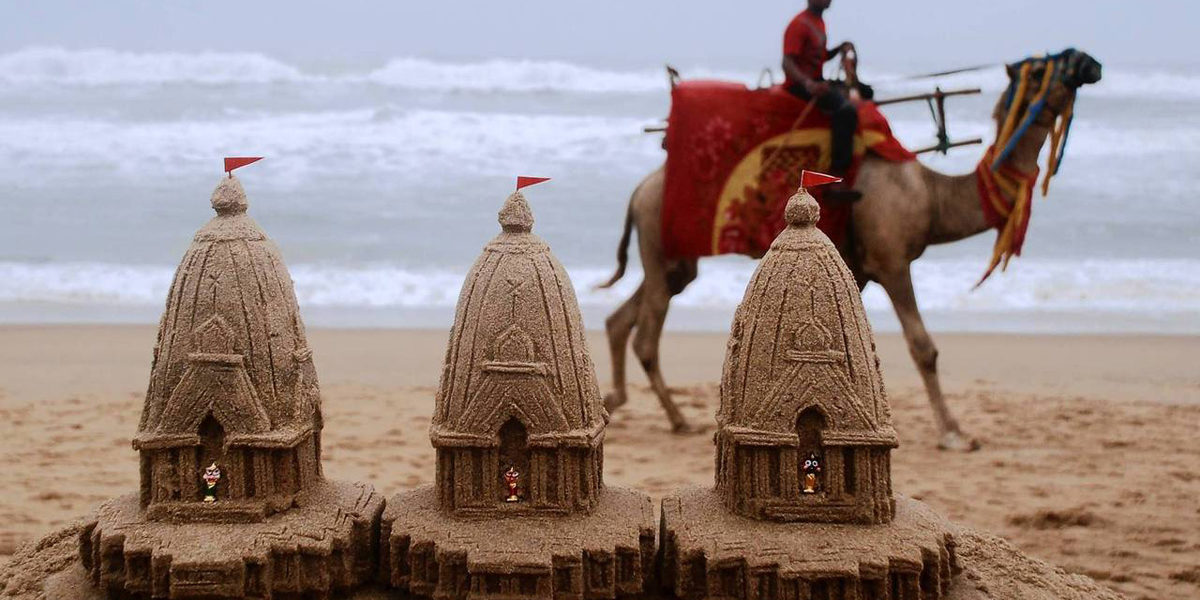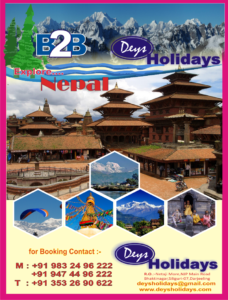Puri is a city and a municipality in the state of Odisha in eastern India. It is the district headquarters of Puri district and is situated on the Bay of Bengal, 60 kilometres (37 mi) south of the state capital of Bhubaneswar. It is also known as Sri Jagannath Dham after the 12th-century Jagannath Temple located in the city. It is one of the original Char Dham pilgrimage sites for Hindus.
Puri is known by several names since the ancient times, and was locally known as “Shrikhetra” and Lord Jagannath temple is known as “Badadeula”. Puri and the Jagannath Temple were invaded 18 times by Hindu and Muslim rulers, from the 4th century AD till the early 19th century with the objective of looting the treasures of the temple. Odisha, including Puri and its temple, were under the British Raj from 1803 till India attained independence in August 1947. Even though princely states do not exist in India today the heirs of the Gajapati Dynasty of Khurda still perform the ritual duties of the temple. The temple town has many Hindu religious maths or monasteries.
The economy of Puri town is dependent on the religious importance of the Jagannath Temple to the extent of nearly 80 percent. The 24 festivals, including 13 major ones, held every year in the temple complex contribute to the economy; Ratha Yatra and its related festivals are the most important which are attended by millions of people every year. Sand art and applique art are some of the important crafts of the city.
Puri has been chosen as one of the heritage cities for Heritage City Development and Augmentation Yojana (HRIDAY) scheme of Government of India.
Puri, the holy land of Lord Jagannatha, also known by the popular vernacular name Shrikhetra, has many ancient names in the Hindu scriptures such as the Rigveda, Matsya purana, Brahma Purana, Narada Purana, Padma Purana, Skanda Purana, Kapila Purana and Niladrimahodaya. In the Rigveda, in particular, it is mentioned as a place called Purushamandama-grama meaning the place where the Creator deity of the world – Supreme Divinity deified on an altar or mandapa was venerated near the coast and prayers offered with Vedic hymns. Over time the name got changed to Purushottama Puri and further shortened to Puri, and the Purusha came to be known as Jagannatha. Sages like Bhrigu, Atri and Markandeya had their hermitage close to this place. Its name is mentioned, conforming to the deity worshipped, as Srikshetra, Purusottama Dhāma, Purusottama Kshetra, Purusottama Puri and Jagannath Puri. Puri, however, is the popular usage. It is also known by the geographical features of its location as Shankhakshetra (the layout of the town is in the form of a conch shell), Neelāchala (“Blue mountain” a terminology used to name a very large sand lagoon over which the temple was built but this name is not in vogue), Neelāchalakshetra, Neelādri. In Sanskrit, the word “Puri” means town or city,[8] and is cognate with polis in Greek.
Another ancient name is Charita as identified by General Alexander Cunningham of the Archaeological Survey of India, which was later spelled as Che-li-ta-lo by Chinese traveller Hiuen Tsang. When the present temple was built by the Eastern Ganga king Anantavarman Chodaganga in the 11th and 12th centuries AD, it was called Purushottamkshetra. However, the Moghuls, the Marathas and early British rulers called it Purushottama-chhatar or just Chhatar. In Moghul ruler Akbar’s Ain-i-Akbari and subsequent Muslim historical records it was known as Purushottama. In the Sanskrit drama Anargha Raghava Nataka as well, authored by Murari Mishra, a playwright, in the 8th century AD, it is referred to as Purushottama. It was only after the 12th century AD that Puri came to be known by the shortened form of Jagannatha Puri, named after the deity or in a short form as Puri. It is the only shrine in India, where Radha, along with Lakshmi, Saraswati, Durga, Bhudevi, Sati, Parvati, and Shakti, abodes with Krishna, who is also known by the name Jagannath.
Puri is the site of the Govardhana Matha, one of the four cardinal institutions established by Adi Shankaracharya, when he visited Puri in 810 AD, and since then it has become an important dham (divine centre) for the Hindus; the others being those at Sringeri, Dwarka and Jyotirmath. The Matha (monastery of various Hindu sects) is headed by Jagatguru Shankarachrya. It is a local belief about these dhams that Lord Vishnu takes his dinner at Puri, has his bath at Rameshwaram, spends the night at Dwarka and does penance at Badrinath.
In the 16th century, Chaitanya Mahaprabhu of Bengal established the Bhakti movements of India, now known by the name the Hare Krishna movement. He spent many years as a devotee of Jagannatha at Puri; he is said to have merged with the deity. There is also a matha of Chaitanya Mahaprabhu here known as Radhakanta Math.
In the 17th century, for the sailors sailing on the east coast of India, the temple served as a landmark, being located in a plaza in the centre of the city, which they called the “White Pagoda” while the Konark Sun Temple, 60 kilometres (37 mi) away to the east of Puri, was known as the “Black Pagoda”.
The iconic representation of the images in the Jagannatha temple is believed to be the forms derived from the worship made by the tribal groups of Sabaras belonging to northern Odisha. These images are replaced at regular intervals as the wood deteriorates. This replacement is a special event carried out ritualistically by special group of carpenters.
Govardhana matha main gate
The city has many other Mathas as well. The Emar Matha was founded by the Tamil Vaishnava saint Ramanujacharya in the 12th century AD. This Matha, which is now located in front of Simhadvara across the eastern corner of the Jagannath Temple, is reported to have been built in the 16th century during the reign of kings of Suryavamsi Gajapatis. The Matha was in the news on 25 February 2011 for the large cache of 522 silver slabs unearthed from a closed chamber.
The British conquered Orissa in 1803, and, recognizing the importance of the Jagannatha Temple in the life of the people of the state, they initially appointed an official to look after the temple’s affairs and later declared the temple as part of a district.
Jagannatha Temple at Puri
The Jagannatha Temple at Puri is one of the major Hindu temples built in the Kalinga style of architecture. The temple tower, with a spire, rises to a height of 58 meters (190 ft), and a flag is unfurled above it, fixed over a wheel (chakra).
Left:Ritual chakra and flags at the top shikhara of Puri temple of Jagannathaalso related to Sudarsana chakra. The red flag (12 hand or 14 feet (4.3 m) denotes that Jagannath is within the temple.
The temple is built on an elevated platform (of about 420,000 square feet (39,000 m2) area), 20 feet (6.1 m) above the adjacent area. The temple rises to a height of 214 feet (65 m) above the road level. The temple complex covers an area of 10.7 acres (4.3 ha). There are four entry gates in four cardinal directions of the temple, each gate located at the central part of the walls. These gates are: the eastern gate called the Singhadwara (Lions Gate), the southern gate known as Ashwa Dwara (Horse Gate), the western gate called the Vyaghra Dwara (Tigers Gate) or the Khanja Gate, and the northern gate called the Hathi Dwara or (elephant gate). These four gates symbolize the four fundamental principles of Dharma (right conduct), Jnana (knowledge), Vairagya (renunciation) and Aishwarya (prosperity). The gates are crowned with pyramid shaped structures. There is a stone pillar in front of the Singhadwara, called the Aruna Stambha {Solar Pillar}, 11 metres (36 ft) in height with 16 faces, made of chlorite stone; at the top of the stamba an elegant statue of Arun (Sun) in a prayer mode is mounted. This pillar was shifted from the Konarak Sun Temple. The four gates are decorated with guardian statues in the form of lion, horse mounted men, tigers, and elephants in the name and order of the gates. A pillar made of fossilized wood is used for placing lamps as offering. The Lion Gate (Singhadwara) is the main gate to the temple, which is guarded by two guardian deities Jaya and Vijaya. The main gate is ascended through 22 steps known as Baisi Pahaca, which are revered, as it is believed to possess “spiritual animation”. Children are made to roll down these steps, from top to bottom, to bring them spiritual happiness. After entering the temple, on the left side, there is a large kitchen where food is prepared in hygienic conditions in huge quantities; the kitchen is called as “the biggest hotel of the world”.
According to a legend King Indradyumma was directed by Lord Jagannath in a dream to build a temple for him which he did as directed. However, according to historical records the temple was started some time during the 12th century by King Chodaganga of the Eastern Ganga dynasty. It was completed by his descendant, Anangabhima Deva, in the 12th century. The wooden images of Jagannath, Balabhadra and Subhadra were then deified here. The temple was under the control of the Hindu rulers up to 1558. Then, when Orissa was occupied by the Afghan Nawab of Bengal, it was brought under the control of the Afghan General Kalapahad. Following the defeat of the Afghan king by Raja Mansingh, the General of Mughal emperor Akbar, the temple became part of the Mughal empire till 1751. Subsequently, it was under the control of the Marathas till 1803. During the British Raj, the Puri Raja was entrusted with its management until 1947.
The triad of images in the temple are of Jagannatha, personifying Lord Krishna, Balabhadra, His older brother, and Subhadra, His younger sister. The images are made of neem wood in an unfinished form. The stumps of wood which form the images of the brothers have human arms, while that of Subhadra does not have any arms. The heads are large, painted and non-carved. The faces are marked with distinctive large circular eyes.
The Pancha Tirtha of Puri
Hindus consider it essential to bathe in the Pancha Tirtha or the five sacred bathing spots of Puri, to complete a pilgrimage to Puri. The five sacred water bodies are the Indradyumana Tank, the Rohini Kunda, the Markandeya Tank, the Swetaganga Tank, and the Bay of Bengal also called the Mahodadhi, in Sanskrit ‘Mahodadhi’ means a “great ocean”; all are considered sacred bathing spots in the Swargadwar area. These tanks have perennial sources of supply from rainfall and ground water.
Gundicha Temple
The Gundicha Temple, known as the Garden House of Jagannatha, stands in the centre of a beautiful garden, bounded by compound walls on all sides. It lies at a distance of about 3 kilometres (1.9 mi) to the northeast of the Jagannatha Temple. The two temples are located at the two ends of the Bada Danda (Grand Avenue), which is the pathway for the Rath Yatra. According to a legend, Gundicha was the wife of King Indradyumna who originally built the Jagannath temple.
The temple is built using light-grey sandstone, and, architecturally, it exemplifies typical Kalinga temple architecture in the Deula style. The complex comprises four components: vimana (tower structure containing the sanctum), jagamohana (assembly hall), nata-mandapa (festival hall) and bhoga-mandapa (hall of offerings). There is also a kitchen connected by a small passage. The temple is set within a garden, and is known as “God’s Summer Garden Retreat” or garden house of Jagannatha. The entire complex, including the garden, is surrounded by a wall which measures 430 by 320 feet (131 m × 98 m) with height of 20 feet (6.1 m).
Except for the 9-day Rath Yatra, when the triad images are worshipped in the Gundicha Temple, otherwise it remains unoccupied for the rest of the year. Tourists can visit the temple after paying an entry fee. Foreigners (generally prohibited entry in the main temple) are allowed inside this temple during this period. The temple is under the Jagannath Temple Administration, Puri, the governing body of the main temple. A small band of servitors maintain the temple.
Swargadwar
Swargadwar is the name given to the cremation ground or burning ghat which is located on the shores of the sea. Here thousands of dead bodies of Hindus brought from faraway places are cremated. It is a belief that the Chitanya Mahaparabhu disappeared from this Swargadwar about 500 years back.
Beach
The beach at Puri, known as the “Ballighai beach, at the mouth of Nunai River, is 8 kilometres (5.0 mi) away from the town and is fringed by casurina trees. It has golden yellow sand. Sunrise and sunset are pleasant scenic attractions here. Waves break in at the beach which is long and wide.
District museum
The Puri district museum is located on the station road where the exhibits in display are the different types of garments worn by Lord Jagannath, local sculptures, patachitra (traditional, cloth-based scroll painting), ancient Palm-leaf manuscripts, and local craft work.
Raghunandana library
Raghunandana Library is located in the Emara Matha complex (opposite Simhadwara or lion gate, the main entrance gate). The Jagannatha Aitihasika Gavesana Samiti (Jagannatha Historical Centre) is also located here. The library houses ancient palm leaf manuscripts on Jagannatha, His cult and the history of the city.
Festivals of Puri
Puri witnesses 24 festivals every year, of which 13 are major. The most important of these is the Rath Yatra, or the car festival, held in the June–July, which is attended by more than 1 million people.
Rath Yatra at Puri
The Jagannatha Temple triad are normally worshipped in the sanctum of the temple at Puri, but once during the month of Asadha (rainy season of Orissa, usually in June or July), they are brought out on the Bada Danda (main street of Puri) and taken over a distance of (3 kilometres (1.9 mi)) to the Shri Gundicha Temple in huge chariots (ratha), allowing the public to have darśana (holy view). This festival is known as the Rath Yatra, meaning the journey (yatra) of the chariots. The yatra starts every year according to the Hindu calendar on the Asadha Sukla Dwitiya day, the second day of bright fortnight of Asadha (June–July).
Historically, the ruling Ganga dynasty instituted the Rath Yatra on the completion of the Jagannatha Temple around 1150 AD. This festival was one of those Hindu festivals that was reported to the Western world very early. Friar Odoric, in his account of 1321, reported how the people put the “idols” on chariots, and the King, the Queen and all the people drew them from the “church” with song and music.
The Rathas are huge wooden structures provided with large wheels, which are built anew every year and are pulled by the devotees. The chariot for Lord Jagannatha is about 45 feet (14 m) high and 35 square feet (3.3 m2) and takes about 2 months for its construction. The chariot is mounted with 16 wheels, each of 7 feet (2.1 m) diameter. The carving in the front face of the chariot has four wooden horses drawn by Maruti. On its other three faces, the wooden carvings are of Rama, Surya and Vishnu. The chariot is known as Nandi Ghosha. The roof of the chariot is covered with yellow and golden colored cloth. The next chariot is of Balabhadra which is 44 feet (13 m) in height fitted with 14 wheels. The chariot is carved with Satyaki as the charioteer. The carvings on this chariot include images of Narasimha and Rudra as Jagannatha’s companions. The next chariot in the order is of Subhadra, which is 43 feet (13 m) in height supported on 12 wheels, roof covered in black and red colour cloth, and the chariot is known as Darpa Dalaan and the charioteer carved is Arjuna. Other images carved on the chariot are of Vana Durga, Tara Devi and Chandi Devi. The artists and painters of Puri decorate the cars and paint flower petals and other designs on the wheels, the wood-carved charioteer and horses, and the inverted lotuses on the wall behind the throne. The chariots of Jagannath pulled during Rath Yatra is the etymological origin of the English word Juggernaut. The Ratha Yatra is also termed as the Shri Gundicha yatra and Ghosha yatra.
Chhera Pahara
The Chhera Pahara (sweeping with water) is a significant ritual associated with the Ratha Yatra. During this ritual, the Gajapati King wears the outfit of a sweeper and sweeps all around the deities and chariots. The king cleans the road in front of the chariots with a gold-handled broom and sprinkles sandalwood water and powder. As per the custom, although the Gajapati King has been considered the most exalted person in the Kalingan kingdom, he still renders the menial service to Jagannatha. This ritual signifies that under the lordship of Jagannatha, there is no distinction between the powerful sovereign and the humblest devotee.
Chandan Yatra
The Chandan Yatra festival held every year on Akshaya Tritiya day marks the commencement of the construction of the chariots of the Rath Yatra. It also marks the celebration of the Hindu new year.
Snana Yatra
Every year, on the Purnima day in the Hindu calendar month of Jyestha (June), the triad images of the Jagannatha Temple are ceremonially bathed and decorated on the occasion of Snana Yatra. Water for the bath is taken in 108 pots from the Suna kuan (meaning: “golden well”) located near the northern gate of the temple. Water is drawn from this well only once in a year for the sole purpose of the religious bath of the deities. After the bath the triad images are dressed in the fashion of the elephant god, Ganesha. Later, during the night, the original triad images are taken out in a procession back to the main temple but kept at a place known as Anasara pindi. After this the Jhulana Yatra is performed when proxy images of the deities are taken out in a grand procession for 21 days, cruised over boats in the Narmada tank.
Anavasara or Anasara
Anasara, a derivative of the Sanskrit word “Anabasara”, literally means vacation. Every year after the holy Snana Yatra, the triad images, without the Sudarshana Chakra, are taken to a secret altar named Anavasara Ghar (also known as Anasara pindi, ‘pindi’ is Oriya term meaning “platform” ) where they remain for the next fortnight of (Krishna paksha); devotees are not allowed to view these images. Instead, devotees go to the nearby Brahmagiri to see the Lord in the four-handed form of Alarnath, a depiction of Vishnu. Devotees then get the first glimpse of the Lord only on the day before Rath Yatra, which is called Navayouvana. It is a local belief that the gods suffer from fever after taking an elaborate ritual bath, and they are treated by the special servants, the Daitapatis, for 15 days. Daitapatis perform special nitis (rites) known as Netrotchhaba (a rite of painting the eyes of the triad). During this period cooked food is not offered to the deities.
Naba Kalebara
Naba Kalebara is one of the most grand events associated with the Lord Jagannatha that takes place when one lunar month of Ashadha is followed by another of Ashadha called Adhika Masa (extra month). This can take place at an interval of 8, 12 or even 18 years. Literally meaning the “New Body” (Nava = New, Kalevar = Body) in Odia, the festival is witnessed by millions of people and the budget for this event generally exceeds $500,000. The event involves installation of new images in the temple and burial of the old ones in the temple premises at Koili Vaikuntha. During the Nabakalebara ceremony held during July 2015 the idols that were installed in the temple in 1996 were replaced by specially carved new images made of neem wood. More than 3 million people are reported to have attended this festival.
Suna Besha
Suna Besha, (‘Suna besh’in English translates to “gold dressing”) also known as Raja or Rajadhiraja Bhesha or Raja Bhesha, is an event when the triad images of the Jagannatha Temple are adorned with gold jewelry. This event is observed five times in a year. It is commonly observed on Magha Purnima (January), Bahuda Ekadashi also known as Asadha Ekadashi (July), Dashahara (Bijayadashami) (October), Karthik Purnima (November), and Pousa Purnima (December). One such Suna Bhesha event is observed on Bahuda Ekadashi during the Rath Yatra on the chariots placed at the Simhadwar. The other four Beshas are observed inside the temple on the Ratna Singhasana (gem studded altar). On this occasion gold plates are decorated over the hands and feet of Jagannatha and Balabhadra; Jagannatha is also adorned with a Chakra (disc) made of gold on the right hand while a silver conch adorns the left hand. Balabhadra is decorated with a plough made of gold on the left hand while a golden mace adorns his right hand.
Niladri Bije
Niladri Bije, celebrated in the Hindu calendar month Asadha (June–July) on Trayodashi (13th day), marks the end of the Ratha Yatra. The large wooden images of the triad of gods are taken out from the chariots and then carried to the sanctum sanctorum, swaying rhythmically; a ritual which is known as pahandi.
Sahi yatra
The Sahi Yatra, considered the world’s biggest open-air theatre, is an annual event lasting 11 days; a traditional cultural theatre festival or folk drama which begins on Ram Navami and ends on Rama avishke (Sanskrit meaning : anointing). The festival includes plays depicting various scenes from the Ramayana. The residents of various localities, or Sahis, are entrusted the task of performing the drama at the street corners.
Samudra Arati
The Samudra arati is a daily tradition started by the present Shankaracharya 9 years ago. The daily practise includes prayer and fire offering to the sea at Swargadwar in Puri by disciples of the Govardhan Matha. On Paush Purnima of every year the Shankaracharya himself comes out to offer prayers to the sea.
Arts and crafts–
Sand art
Sand art is a special art form that is created on the beaches of Puri. The art form is attributed to Balaram Das, a poet who lived in the 14th century. Sculptures of various gods and famous people are now created in sand by amateur artists. These are temporary in nature as they get washed away by waves. This art form has gained international fame in recent years. One of the famed sand artists of Odisha is Sudarshan Patnaik. He established the Golden Sand Art Institute in 1995, in the open air on the shores of Bay of Bengal, to provide training to students interested in this art form.
Appliqué art
Appliqué art, which is a stitching-based craft unlike embroidery, was pioneered by Hatta Maharana of Pipili. It is widely used in Puri, both for decoration of the deities and for sale. Maharana’s family members are employed as darjis or tailors or sebaks by the Maharaja of Puri. They prepare articles for decorating the deities in the temple for various festivals and religious ceremonies. The appliqué works are brightly coloured and patterned fabric in the form of canopies, umbrellas, drapery, carry bags, flags, coverings of dummy horses and cows, and other household textiles; these are marketed in Puri. The cloth used is made in dark colours of red, black, yellow, green, blue and turquoise blue.
Communication-
Earlier, when roads did not exist, people used to walk or travel by animal-drawn vehicles or carriages along beaten tracks to reach Puri. Travel was by riverine craft along the Ganges up to Calcutta, and then on foot or by carriages. It was only during the Maratha rule that the popular Jagannath Sadak (Road) was built around 1790. The East India Company laid the rail track from Calcutta to Puri, which became operational in 1898. Puri is now well-connected by rail, road and air services. A broad gauge railway line of the South Eastern Railways which connects Puri with Calcutta, and Khurda is an important railway junction on this route. The rail distance is about 499 kilometres (310 mi) from Calcutta and 468 kilometres (291 mi) from Vishakhapatnam. Road network includes NH 203 that links the city with Bhubaneswar, the state capital, situated about 60 kilometres (37 mi) away. NH 203 B connects the city with Satapada via Brahmagiri. Marine drive, which is part of NH 203 A, connects Puri with Konark. The nearest airport is the Biju Patnaik International Airport at Bhubaneswar. Puri railway station is among the top hundred booking stations of the Indian Railways.

